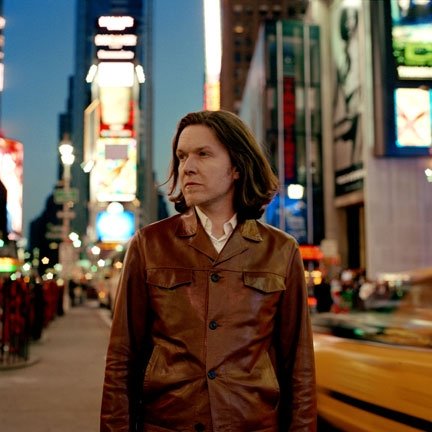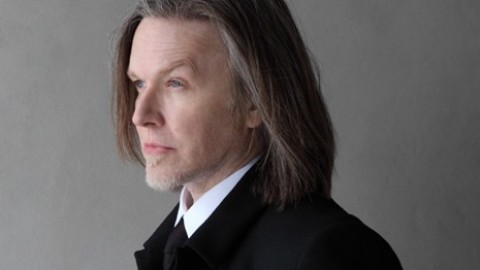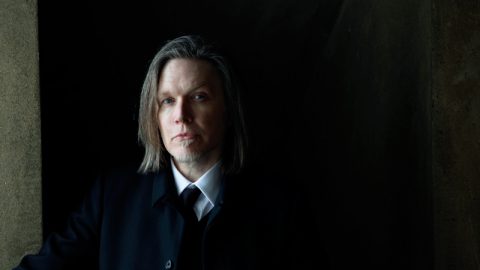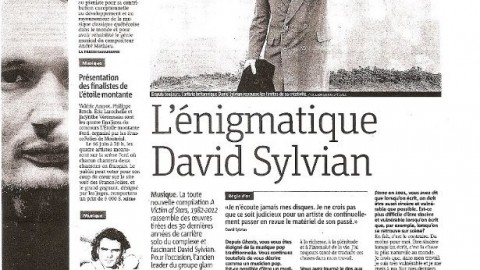
This is the full version of an article written for a Canadian music paper (April, 1999), which the editor found too controversial for him to print. He told me I could not compare religions in his publication, and was unaware that they all stem from the same root myths. He would not let me state that Sylvian practices forms of Hindu worship, and would not let me provide background on his previous esoteric influences. It is no wonder that music journalism seldom rises above the obvious cliches.
Interview by Carl Craig
David Sylvian is in love. That has not always been the state of mind of the vocalist/musician, known for his melancholic jazz-rock and atmospheric ambient work. Once detached and restless he identified with the mythic figure Orpheus, who tempted the karmic wheel by braving the underworld. And when Sylvian reunited with the members of Japan for the Rain Tree Crow project, his self-questioning took on the symbol of the crow, long associated with death, which in occult terms signifies the initiate separated from society by his exploration of the mysteries. But in the twelve years since his last solo recording, Secrets Of The Beehive, much as happened to settle his inner turmoils.
At the end of 1991, while working on a track from Ryuichi Sakamoto’s Heartbeat album he met vocalist Ingrid Chavez (then one of Prince’s Paisley Park artists). Within three months they were married and Sylvian moved from gloomy London to the open skies of Minneapolis, which became a retreat into nature for the lyricist who often used such metaphors to describe his inner conflicts (his collected works is titled Weatherbox). Since then two daughters have joined his newly settled lifestyle. When they are older they can share their father’s current happiness when listening to his love songs to their mother, “Cafe Europe” and “Wanderlust” on his new, cryptically-titled album, Dead Bees On A Cake (Virgin).
But Sylvian’s new work is not just about devotion to his beautiful wife and young family. At some point in their world-travelling romance they discovered a devotion to the Goddess, which has taken the form of their daily puja (Hindu worship) of prayer chants, yoga and vegetarianism. For in the presence of Indian avatars (holy people respected as the Divine presence on earth) Mr & Mrs Sylvian found the peaceful space that he was trying to create with sound/art installations like Ember Glance (made with Russell Mills in 1991). At an ashram in Thalheim, Germany (in farm country between Koln and Frankfurt) Sylvian received a silent blessing, ‘darshana’ (meaning vision), while kneeling before a saintly psychic “Mother” Meera. This turning point in Sylvian’s life was commemorated by the track “Darshan (The Road To Graceland)” on the album he did with guitarist Robert Fripp in 1993. “Bringing Down The Light,” also on their revelatory-titled The First Day album, was further named after a book by Meera discussing her purpose in manifesting “paramatma-jyotis,” “the light of the Supreme Self.”
Most religious practice in India is based on Goddess worship. This is not a projection of post-feminist sentiments but a human metaphor for a most non-human event, the creation of the universe. The divine force that gave birth to the expanding creation was termed feminine, while the divine thought, the Biblical “word” in Genesis, that initiated that separation from the godhead was termed masculine. The father is the unnameable, what is referred to as “the ancient of days” in the Bible, while the mother has many names from each religious tradition – Aditi, Sephira, Holy Ghost and more. The Roman Catholic church tried to co-opt Goddess worship by placing the Virgin Mary into pagan temples and holy days (however the Virgin’s pagan past can still be seen in depictions of her with a halo of twelve stars (ie the zodiac)). Now the female aspect in Sylvian’s pieces such as “All My Mother’s Names,” “Krishna Blue” and “Thalheim,” and even older ones like “Wave” and “Riverman” can be seen as references to the Divine Mother.
“Absolutely, sometimes unconsciously so,” said Sylvian on the phone from his new home in the Napa Hills of California. “But I’ve come to realize that is indeed the case. I guess that is when I recognized my teacher, Sri Sri Mata Amritanandamayi. Everything fell into place for me, in that there was this woman that embodied that power for me, and that imagery. And sometimes they cross over to a degree where I’m not even sure where one begins and another takes over. There are certain pieces on the album which are both written about Ingrid and also my experiences with other teachers relating to the Divine Mother.”
Goddess worship is about a direct connection with the joy of the living creation, rather than the bureaucratic mediation of the spirit by priestly orders in the religions stemming from the Middle East. Part of Sylvian’s daily practice, when his studio’s hard drive isn’t crashing or album artwork is being lost, is to recognize the divine in all things.
“Another teacher brought that to me, Shree Maa, the Indian lady that sings on the penultimate track on the album (“Praise”). She encouraged us to live our lives that way, to look for the divine in one another and worship the divine in one another. Which I think is a really wonderful way to conduct a relationship. And also in your children and all beings essentially. It has become a discipline or practice to look into your loved one’s eyes and find that aspect of their being.”
The opening track and first single, “I Surrender,” is the confirmation of his redemption from his past existential crises, through devotional worship and the submission of the ego (which is what the album title refers to – death of the ego merging with the object of spiritual desire). In “Krishna Blue” he sings about being unbound from the kind of restrictions mentioned in an older song about orthodox religion, “Gone To Earth.”
“The feeling in “Gone To Earth” was being earthbound, being attached in many desirous ways, if you like, and then “Krishna Blue” is talking about how she is enabling me to let go of all of those attachments. Taking away all the obsession with this or that aspect of myself and allowing me to be liberated and to move on. I guess I found that what worked best for me was a very practical discipline, on a daily basis. I like the clarity of Buddhism and I also like the devotional aspect of Hinduism. And my own practice somehow embraces both of those disciplines.”
Sylvian’s search has come a long way since he sang “I understand you’re facing problems inside you / A certain difficulty of being that I know too” on his first solo single “Red Guitar” (1984). The path began in writing the introspective track “Ghosts” for the final Japan studio album, where Sylvian found an unmasked voice and a direction for his own project. “Ghosts” was a personal song about self-doubt, using one of his many weather metaphors, in this case rain which never stops, as a sign of spiritual unease.
“There was no religious upbringing at all in my family. Through my travels in the East the first philosophy I came across that interested me was Buddhist, Zen Buddhism in particular and Shintoism. And as time went on I delved a little more into, supposedly, my own roots, which would be Christianity. I looked into mystical Christianity, which was very interesting to me, and then onto the Kabbala.”
Sylvian’s interest in the Hebrew esoteric system of the Kabbala was seen in the cover art of the 1986 double album Gone To Earth, which was influenced by the hermetic diagrams of Elizabethan scholar Robert Fludd. Fludd was grouped with alchemists and Rosicrucians in the early 17th century for his encyclopaedic history of the cosmos based on the study of nature and a belief in a spiritual hierarchy of creation. Russell Mill’s cover painting for Gone To Earth featured three spheres representing the created universe (the heavens, solar bodies and the elements). The influence of the divine is seen coming from a semi-circle connected to the top of the three spheres, called in the Kabbala, Kether (or crown – termed Nirvana in Buddhism) and is mediated by a triangle representing the sun, before passing to the earth at the center of the created universe.
Gone To Earth featured a kind of British occult supergroup, as Sylvian worked with the esoterically-minded guitarists Bill Nelson and Robert Fripp. Nelson has often expressed his interest in magick and the Rosicrucians, and named his label after an artist Sylvian also admired, Jean Cocteau (who was said to be the head of a modern day order of Rosicrucians related to the bloodline of Christ in the book Holy Blood Holy Grail). Fripp had dropped out of the music business in 1974 to study with JG Bennett, a British student of the Armenian mystic Gurdjieff (the subject of the biographical film Meetings With Remarkable Men, who died in 1949). Gurdjieff’s system for self-awareness drew from many esoteric traditions and brought to the West techniques to break through the automatic reflexes and conditioned habits of our normative state he described as waking sleep. Sylvian often writes about ‘sleep’ and ‘dreaming’ with this meaning in mind, (“Silver Moon,” “Riverman,” “Firepower”) and sampled Bennett retelling a moment from his autobiography, Witness, in “Upon This Earth” for the Gone To Earth album.
“The context the sample was used in it was like this moment of clarity in an otherwise chaotic universe. So it was to indicate, to some degree, the possibility of divine insight, if you like. I think on any path of spiritual development you have these moments of revelation, of liberation, you know, you suddenly stand on some fresh ground. There is a clarity to those moments which are really intense. They don’t always last for that long. You can be immediately plunged into a whole new process. A whole new cycle and you have to get on with that. But those moments of clarity, those mini epiphanies, are so strong that they drive you on, regardless.”
According to a recent biography, David Sylvian – The Last Romantic (by Martin Power, Omnibus Press) the connection he gained with the albums in 1986 and ’87 wavered in 1988 when a depression led him to analysis.
“The depression, I think, was biochemical. I had nothing in my life that I felt should have caused it. And that was the confusion to me, because I went through post-Freudian analysis, I did the whole deal. Although I learned a great deal about that and I managed to resolve a lot of things in my life, I still feel the basic depression was not necessarily caused through my own state of mind. So that was a very difficult, intense and prolonged period of time, that saw me through right up until I met my wife, really. Which drew me out of it. And that was during the period of time I was working with Robert, also, which kind of documents a lot of that negativity that I was experiencing. But hopefully with a resolution, because I was beginning to come to the end of it.”
However, Dead Bees On A Cake is not all goodness and light. Sylvian draws on his negative experiences and the moody textures of his ambient work to express the mysterious realities that surround us, with edgy tracks like the Navajo-inspired “Pollen Path” and off-kilter “God Man.”
“I think that the shadow side of human nature should be represented, like doubt or anger or fear, things that should also be embraced and understood, and not shut away somewhere. I don’t think we can attach ourselves to an art work that doesn’t hold the possibility of all the aspects of human nature. I found that with the ambient work done with Holger Czukay. So much of the music produced under that heading was like an artificial sweetener. It was music that was supposedly pure but was too pure for its own good. It didn’t allow for certain negative states of mind to be embraced and transformed. I’ve always tried to embrace that shadow side of human nature, as well as the positive side, so as to be able to make that transformation from dark to light. Some of my pieces are very drawn out graphically in that nature. “Let The Happiness In” is very much a kind of map, if you like, helping to create a sense of uplifting from the rather pessimistic starting point. And I hope the work allows people to find themselves within it, regardless of the state of mind with which they approach it.”
Dead Bees On A Cake succeeds in that regard by working on both personal and deeper esoteric levels. This humble superstar isn’t one to insist on releasing the innate genius of his fans, like PTV’s Genesis P or Ministry’s Al Jourgenson, who read passages from Aleister Crowley’s Book Of Lies to unsuspecting Lollapalooza crowds. He’s happy merely to express the moments of insight won along the way – lyrical and musical trophies from the “path way of the heart.”
You use the image of lightning and thunder a lot, does that refer to revelation?
Yeah, they can be interpreted in different ways, but yes they can be interpreted that way too. I don’t like to be too specific about it. They are obvious references, I think. And thunder and lightning can certainly be interpreted in that way.
There is a song on the new album where you refer to lightning in the spine, does that refer to kundalini?
Uh huh. Yeah.
In “Krishna Blue” you sing the lines “you open the gates/the madness begins,” meaning that the hard part begins after you are inspired by a revelatory experience?
Yeah because you have to start facing yourself in so many different ways. And some of that can be very unpleasant and very painful. The process isn’t easy. There is a lot to be looked at that. Stuff that has been shunted under the carpet and pushed away. You have to face it, you have to go through this process of letting everything rise to the surface and take a good look at it and try to relieve yourself of those qualities, so you can move on. But there has to be an embracing of them before you can let go of them. So it is extremely difficult at times.
The title “Pollen Path” you mentioned was a reference to a Joseph Campbell lecture about American Indian spirituality. To me that seems to refer to the beauty of nature, the aliveness of everything around you.
Yeah. Absolutely, and again with the teachers I have been with, they are able to experience that as being palpably real. Just seeing the divinity in all things. So the beauty exists, it is, its not subjective. It is something we have to grow into understanding, to become more and more conscious of, to be able to understand the beauty of the world. We are too selective in what we perceive to be beautiful and not so beautiful. And just being around these people that don’t think that way, that don’t see the world that way is quite liberating, quite intense.
And so is the edginess of that song the frightened child inside that doesn’t want to deal with this kind of awareness?
Yeah, its the chaotic nature of life on earth in so many of its aspects. Both the personal and the worldly, I mean, the world is a pretty chaotic and frightening place. And its acknowledging that, and at the same time crying out, yearning for this recognition, being recognized by the divine, if you like. That you could be graced by the presence of divinity.
So in the second half of the tune, where you are more quiet, is that a shrinking away from that reality?
No I think it is coming to the same conclusions with a more quieter state of mind, in periods of reflection. It is not the most optimistic piece on the album, it’s a piece embraces a lot of doubt and questioning. But it’s basically asking the same question, you know.
So these songs are little mystery plays even, because in “Pollen Path” when you ask for the Mother’s name you are answered by silence.
Uh huh, yeah. Again there is many ways to interpret that and I’d like to leave that open.
I was wondering who the guitarist on that track is?
I’m playing all the electric guitar and Marc Ribot is playing the acoustic slide guitar.
So you are playing the edgy, noisey guitar?
Yeah.
And in the next track “All My Mother’s Names”?
That’s Marc Ribot.
It reminds me of Arto Lindsay’s strangulated sound.
Right, yeah. We had a wonderful session one afternoon together in New York. He gave me a lot of material to work with, it was a really fantastic session.
When you sample other people’s voices, like Joseph Beuys and JG Bennett, do they function as authorities, a wise voice?
In terms of sampling the Bennett piece, yeah for sure. Because of the context it was used in it was like this moment of clarity in an otherwise chaotic universe, you know. So it was to indicate that to some degree, the possibility of divine insight, if you like. Bueys was used just because of what was being said, but it is also the reference to Bueys the man and his theories and philosophy all tied up in the use of his voice, which is something I felt a strong connection with. I find Bueys to be one of the most fascinating and influential artists of the 20th Century.
And now on “Praise” you have Shree Maa. What is she singing?
The song she is singing in “Praise” is a song to the Divine Mother. Each verse deals with a different aspect of the Divine Mother. But it is basically a song of praise to each aspect. It is something that is normally sung after a period of worship. So the first line would be “in the morning I bow down to…” and then it would say the name of the particular aspect, and go on to list those aspects.
Was it a problem to provide music to Shree Maa’s song, which might have had Indian scales?
No actually, it came to be very easy. She sang the piece unaccompanied and she has wonderful pitching. So no, it was actually quite easy to come up with a chord sequence for it.
As a writer do you find it challenging that the mystical concepts you are trying to describe are best done with images that are beyond words?
We tend to respond to certain images in very similar ways. I think when we stand in a particular kind of relation, a particular kind of landscape, then we share a similar response to it in some ways. There is a certain power in nature that draws upon us or acts within us. But there are moments in time when we can experience a multitude of emotions almost simultaneous. Even contradictory emotions. A feeling of isolation, a feeling of unity, a sadness, a joy. And because of that reaction that bonds us together, if you like, I try to use imagery that has a similar quality to it. That might have, possibly, a universal response. It’s difficult because we are dealing with subject matter that is beyond language, but I have the added luxury of working with music which can speak so much more. And lend so much more to a sentence, you know, just through the power of the accompaniment.
It seems difficult. In “Wanderlust” you say “I’m taking no sides now that I recognize you” which means there are no sides because the life force is a totality.
Yes. It’s true, but as I say I may write it from one perspective but I think they are open to interpretation. And people may take them in different ways. And I like to leave that open as much as I possibly can so people can find themselves within the work – relate it to their own lives and what it might mean to them.
Are you planning a tour?
We’ve put it off until I complete the work I want to do prior to touring. So it will either begin at the end of ’99 or Feb 2000.
picked a band yet?
No yet, no.
Did Sakamoto do a new version of “Forbidden Colours”?
That’s done. I’m not sure when that will surface, fairly shortly I’d imagine. Maybe May.
And you sang a new version?
Yeah.
Update: “A re-recorded version of Forbidden Colours, with David on vocals, will be included on the Ryuichi Sakamoto album “Cinemage” to be released worldwide (except Japan) by Sony Classical on January 3, 2000. This release includes new orchestral versions of The Last Emperor, El Mar Mediterrani (from the opening ceremonies of the 1992 Summer Olympics), and Forbidden Colours, with David Sylvian.”
Will be releasing the recordings from the Slow Fire tour?
Yes I did record it, no plans to release it as yet.
Weatherbox reissue?
They were going to re-release that prior to this album. I think they’ve lost some of the artwork and they are struggling to find it, is what has happened. I think it would be a wonderful thing if they could put that back out there.
remastering those albums?
That would be a good idea. What is happening is that Virgin have been asking me for a compilation album for some time. And I’ve put it off because I wanted to get this album out before I started work on a compilation. So that is what I’ll be working on next. It’s re-singing, remixing pieces from the past and pulling together all the different collaborative work that I’ve been involved with, as well as the solo work.
So things you did for other labels will be on this compilation?
Yeah.
Are you taking part on Robin Guthrie’s album?
This is actually Russell Mills’ album. Robin is involved with it, maybe as producer, I’m not sure. There is a possibility that I’ll be involved with it, yeah. I’m working on the material now.
Update: Russell Mills aka Undark’s Pearl and Umbra is due late Sept. Featuring guests: David Sylvian, Brian Eno, Bill Laswell, Michael Brook, Harold Budd, Peter Gabriel, Sussan Deyhim, Roger Eno, Eraldo Bernocchi, Graham Haynes, Robin Guthrie, Mitsuo Hector Zazou, Thurston Moore, Paul Schutze, Mark Clifford, Graham Lewis, Ian McCullough, Kevin Shields and more.
Any other things planned?
There is going to be some remixes of “God Man,” the second single, but I’m not sure who’s undertaking that just yet. And there will be a few other collaborations down the line but I shouldn’t really talk about them as they are just in the process of being discussed.
Update: due Sept. “Special limited, numbered edition of 5000 mini album has Guy Sigsworth and Wagon Christ remixes of the title track plus two versions of “Shadowland”. In addition the enhanced element has a 14 minute autobiographical film (previously sent out as an EPK for press).”
1.Godman (album version)
2.Shadowland
3.Godman (Wagon Christ remix)
4.Shadowland (Northfield) – Ingrid Chavez vocal
5.Godman (Guy Sigsworth remix)
6.Time Spent – a short film by David and Ingrid
Also on the way: Approaching Silence CD
due in UK end of Sept. due in Canada mid Oct. “Instrumental album that includes the music from the David Sylvian / Robert Fripp installation in Tokyo 1994 “Redemption – Approaching Silence” (previously limited cassette-only in Japan), together with the two pieces previously released on the 1991 limited edition “Ember Glance” special boxed set. The track listing is as follows:-
1. The Beekeeper’s Apprentice
2. Epiphany
3. Approaching Silence”
“Japanese version has bonus fourth track.”













